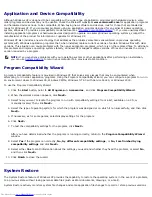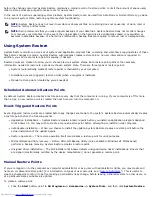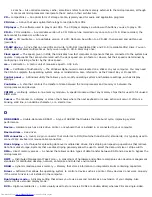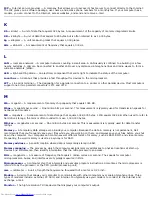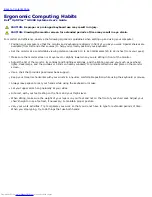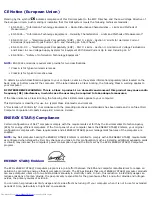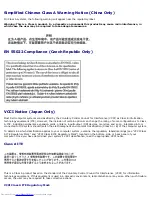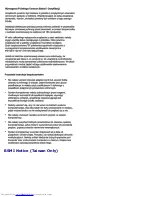
Network connections cannot be protected by surge protectors. Always disconnect the network cable from the network
connector during electrical storms.
System board —
The main circuit board in your computer. Also known as the motherboard.
System setup program —
A utility that serves as an interface between the computer hardware and the operating system.
System setup allows you to configure user-selectable options in the BIOS such as date and time or system password. Unless
you understand what effect the settings have on the computer, do not change the settings for this program.
System tray —
The section of the Windows taskbar that contains icons for providing quick access to programs and computer
functions, such as the clock, volume control, and print status. Also referred to as notification area.
T
TAPI —
telephony application programming interface — Enables Microsoft Windows program applications to operate with a
wide variety of telephony devices, including voice, data, fax, video, and so on.
Text editor —
A program used to create and edit files that contain only text; for example, Windows Notepad uses a text
editor. Text editors do not usually provide word wrap or formatting functionality (the option to underline, change fonts, and so
on).
U
UPS —
uninterruptible power supply — A backup power source used when the electrical power fails or drops to an
unacceptable voltage level. A UPS keeps a computer running for a limited amount of time when there is no electrical power.
UPS systems typically provide surge suppression and may also provide voltage regulation. Small UPS systems provide battery
power for a few minutes to enable you to shut down your computer.
USB —
universal serial bus — A hardware interface for a low-speed device such as a USB-compatible keyboard, mouse,
joystick, scanner, set of speakers, or printer. Devices are plugged directly into a 4-pin socket on your computer or into a
multi-port hub that plugs into your computer. USB devices can be connected and disconnected while the computer is turned
on, and they can also be daisy-chained together.
V
Video controller —
The circuitry on a video card or on the system board (in computers with an integrated video controller)
that provides the video capabilities—in combination with the monitor—for your computer.
Video memory —
Memory that consists of memory chips dedicated to video functions. Video memory is usually faster than
system memory. The amount of video memory installed primarily influences the number of colors that a program can display.
Video mode —
A mode that describes how text and graphics are displayed on a monitor. Graphics-based software, such as
the Windows operating system, displays in video modes that can be defined as
x
horizontal pixels by
y
vertical pixels by
z
colors. Character-based software, such as text editors, displays in video modes that can be defined as
x
columns by
y
rows of
characters.
Video resolution —
See resolution.
Virus —
A program that is designed to inconvenience you or to destroy data stored on your computer. A virus program
moves from one computer to another via an infected disk, software downloaded from the Internet, or e-mail attachments.
When an infected program starts, its embedded virus also starts.
A virus cannot be attached to data. It must be attached to a program that is downloaded into or installed on the computer.
Macro viruses, although hidden within documents (data), are similar. It is in the execution of the macro that the damage is
done.
A common type of virus is a boot virus, which is stored in the boot sectors of a floppy disk. If the floppy disk is left in the
drive when the computer is shut down and then turned on, the computer is infected when it reads the boot sectors of the
floppy disk expecting to find the operating system. If the computer is infected, the boot virus may replicate itself onto all of
the floppy disks that are read or written in that computer until the virus is eradicated.
V —
volt — The measurement of electric potential or electromotive force. One V appears across a resistance of 1 ohm when a
Summary of Contents for GX260 - Optiplex Pentium 4 2.0GHz 512MB 40GB CD
Page 6: ......
Page 29: ......
Page 37: ...Back to Contents Page ...
Page 40: ...information on resetting the chassis intrusion detector Back to Contents Page ...
Page 73: ......
Page 76: ......
Page 86: ...2 padlock ring 3 two release buttons one on each side Back to Contents Page ...
Page 111: ......
Page 128: ...1 release buttons 2 security cable slot 3 padlock ring Back to Contents Page ...
Page 155: ...Back to Contents Page ...
Page 186: ...Back to Contents Page ...
Page 210: ...Back to Contents Page ...
Page 232: ...BSMI Notice Taiwan Only ...

